Tactical Nymphing Sighter
I have decided to discontinue the Tactical Nymphing Sighter.
Orvis has introduced a "Tactical Sighter Tippet," which is very nearly identical, although without the black bars separating the colors. If you miss them, a waterproof marker should suffice.
Orvis, I am sincerely flattered.
The TenkaraBum Tactical Nymphing Sighter gives you more options to customize your sighter than you'll get with any other sighter material. With just one package you get seven possible color combinations, so you can always fish the best sighter color combination for the water and lighting conditions.
Photographing a sighter in use is horribly difficult with a point and shoot camera. The camera always wants to focus on the background. When the sighter is dancing around because there is a 15" brown trout on the end of the line it becomes doubly difficult.
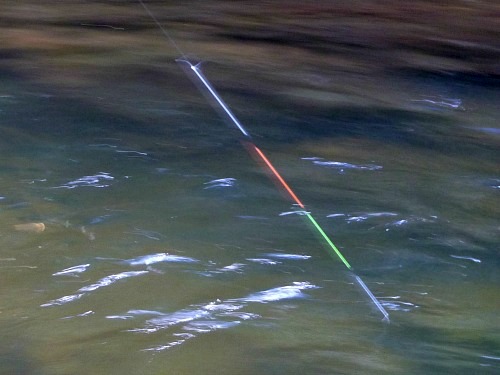 TenkaraBum Tactical Nymphing Sighter in action.
TenkaraBum Tactical Nymphing Sighter in action.Nonetheless, the photo above is a reasonably close representation of the TenkaraBum Tactical Nymphing Sighter. To be a bit more precise, the photo shows one possibility for how you can cut the sighter to fit your own preferences.
Each package of the TenkaraBum Tactical Nymphing Sighter contains three lengths of line, each over 7' long (about 22' in total). The photo above shows a three foot length cut from one of the lines.
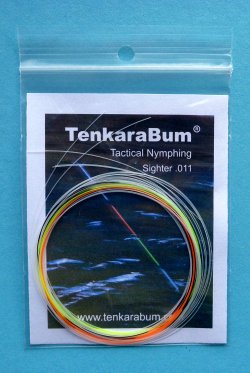 TenkaraBum Tactical Nymphing Sighter
TenkaraBum Tactical Nymphing SighterThe breakdown of white and hi-vis has changed from last year. The new TenkaraBum Tactical Nymphing sighter has the three 7+ foot lines. Each line has a pattern which repeats once. The pattern is 13" of white, 18 1/2" that is black, fluorescent orange, black, fluorescent chartreuse, black, and then another 13" of white. That sequence then repeats, so you get white, hi-vis, long white (13"+13"), hi-vis and white. Thus, one package gives you the option to cut a multitude of sighters to fit any lighting or water conditions.
With the TenkaraBum Tactical Nymphing Sighter, your choices include white,
orange over white, chartreuse over white, orange over chartreuse over
white, chartreuse over orange over white, white over orange over chartreuse over white (as in the photo above), or multicolor orange and chartreuse. A black bar separates each color and really makes them stand out.
You cannot get that degree of flexibility in any other sighter!
I am sure some tenkara anglers will wonder what all the fuss is about with respect to sighters. After all, tenkara anglers use hi-vis lines, so the entire line is effectively a sighter. In a sense, that is true, but there are a couple very valid reasons a tenkara angler may wish to use a sighter.
Tom Davis uses a few inches of fluorescent chartreuse line attached to the end of his fluorescent orange tenkara line. The contrasting color makes it easier to concentrate on the end of the line when watching it for the slightest twitch or hesitation. Essentially, he is adding even more hi-vis to an already hi-vis rig.
Rob Worthing, on the other hand, uses a sighter to dramatically reduce the hi-vis nature of his tenkara line, to the point where he uses a hard to see "stealth" smoke gray casting line and a white sighter. As I have mentioned with respect to the Fujino White tenkara line, white is really an excellent color for a line or a sighter. It is very easy for the angler to see against dark water, and very hard for the fish to see against the bright sky.
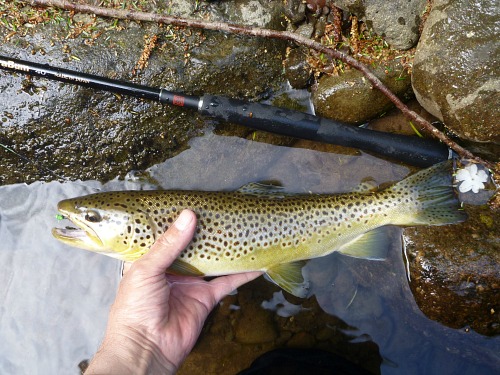 The 15" brown that made the Tactical Nymphing Sighter photo blurry.
The 15" brown that made the Tactical Nymphing Sighter photo blurry.A white sighter has another (slightly unexpected) advantage. First a
bit of background: Paul Gaskell and John Pearson of Discover Tenkara
learned through extensive record keeping that their catch rate increased
by a whopping 700% just by keeping their hi-vis tenkara line completely
off the water's surface at all times. I had noticed when I first adopted
a fluorescent orange saltwater fishing line for tenkara (back when no
one made an orange tenkara line!) that I seemed to catch more fish when I
kept the end of the line above the surface. I didn't do the
extensive testing and record keeping that Paul and John did, though, and thought keeping the orange line above the surface just improved its sensitivity for strike detection.
The unexpected advantage of the white sighter was discovered by Rob Worthing, who learned that he could fish with most or even all of the white sighter below the surface and it didn't seem to scare the fish - even large, wary, highly pressured fish. Unless the water was extremely muddy, the white sighter was still visible and still effective at indicating strikes.
That is a huge advantage when you have to fish your fly at depth, but the depth keeps changing as you work your way upstream, variously fishing pools, riffles and runs.
The white sighter does have one disadvantage, though, and that is when there is foam or glare on the water. That is when the bright orange or bright chartreuse becomes extremely valuable.
White is much stealthier than the fluorescent orange or fluorescent chartreuse, though, so you really might want to have an orange over white or chartreuse over white sighter. That keeps the hi-vis line further away from the surface, and still lets you sink the white portion if necessary to get additional depth. When visibility is poor, though, or when fishing rushing white water, using an orange and chartreuse sighter will give you much better strike detection.
Rob Worthing has put a lot of thought into sighter colors. He says that orange is more visible in the sunlight and the chartreuse is more visible in the shade. Depending on the lighting where you are fishing, you might choose orange over white or chartreuse over white. Orange over chartreuse over white covers both bases and still keeps the hi-vis portion of the sighter well off the water's surface.
Rob and his partners in the Tenkara Guides, LLC, Erik Ostrander and John Vetterli, have been pushing the envelope for years now, blurring the boundaries between tenkara as practiced in Japan and what was initially called Czech Nymphing, then Euro-nymphing and what Rob now calls Tactical Nymphing.
As Takahashi san has shown, catching over 120 fish on a highly
pressured stretch of water at Itoshiro, Japan, a blending of traditional
tenkara and tactical nymphing can yield tremendous benefits, and is not limited to the American upstarts.
Worthing and Takahashi have clearly shown that tenkara anglers can draw upon the techniques employed by competition anglers. Freed from the constraints of the rules for international competition and using longer, more sensitive tenkara rods (Rob uses the TenkaraBum 40 when guiding and teaching Tactical Nymphing), you can fish nymphs even more effectively than the competition anglers do.
I think they are definitely on to something - something that is really just starting to take hold among American tenkara anglers. It isn't "tenkara," but it is done with tenkara rods.
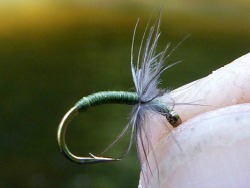
I think the TenkaraBum Tactical Nymphing sighter will have application well beyond tactical nymphing. The advantages of a stealthy line are applicable to fishing unweighted kebari as well as weighted nymphs.
The dramatic improvement that Paul Gaskell and John Pearson discovered from keeping their hi-vis line off the surface while fishing Japanese kebari patterns should be even greater if the line isn't hi-vis to begin with. A white sighter and clear line cut from heavy tippet material is much stealthier than a bright orange or chartreuse or pink line.
Size 3 tenkara line, which is a good choice for nymphing with a tenkara rod, is the same diameter as 0X tippet (size 2.5 is 1X and size 4 is -2X, all of which are available in the excellent Varivas Fluorocarbon tippet material). The line itself will cast just as well if it is 0X tippet instead of size 3 tenkara line.
The TenkaraBum Tactical Nymphing Sighter .011 is the same diameter as size 3 tenkara line or 0X tippet. Because the sighter is nylon rather than fluorocarbon, there will be a bit of hinging, but I believe the advantage of additional stealth may more than offset that. You can eliminate all hinging if you use two of the sighters tied together as your tenkara line. Nylon line is harder to cast, particularly if there is any breeze, but it is a very stealthy line.
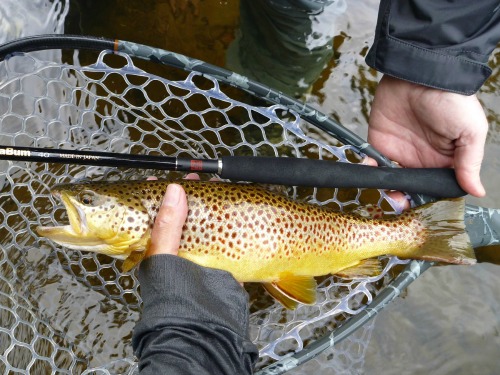
In broken water, or for fish that are not highly pressured, a stealthier line might not be necessary - after all, most American tenkara anglers seem to do quite well with hi-vis lines. I know I have. For highly pressured fish, or perhaps for older, wiser, harder to catch fish, the additional stealth of a lo-vis line and white sighter might make a big difference.
The feedback I have gotten on a white sighter and clear line has so far been extremely positive. Alan L, fishing in the Driftless region of Wisconsin, used it and had his best ever day of trout fishing. Rob Worthing reported that he had asked Matt S. and Mike L., the organizers of the Midwest Tenkara Fest, where he could find the most technical fishing and most highly pressured fish. Using a sample of the TenkaraBum Tactical Nymphing Sighter I had sent him, Rob reported that he just "vacuumed up the fish." And he must have been because Mike, who is no slouch himself, later wrote that Rob outfished him about 7:1.
Granted, Rob has been exploring this concept for years, and as a Tenkara Guide, he gets more stream time than most of us. Still, he did extremely well with the TenkaraBum Tactical Nymphing Sighter. I am pretty confident that you will, too.
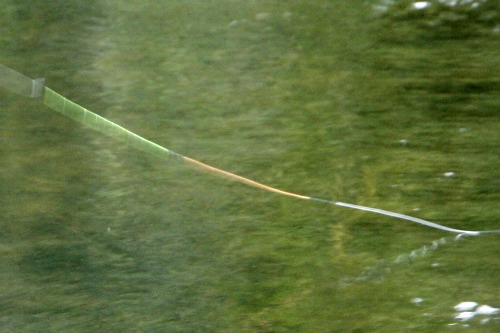
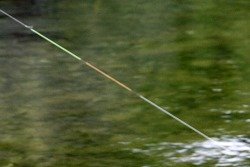
It turns out that the sighter works well in lakes also. In still water, the sighter doesn't really hesitate or twitch, as it will in moving water. The slight line sag that is always present with an unweighted or even lightly weighted fly disappears and the line straightens when a fish takes the fly.
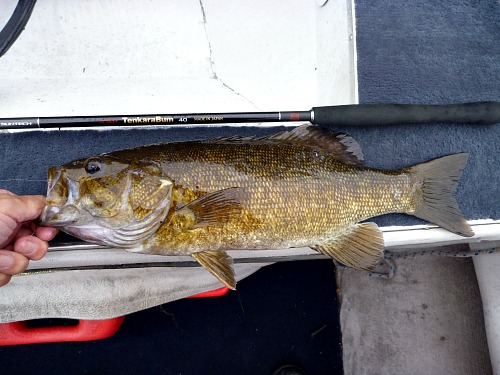 Caught using TenkaraBum Tactical Nymphing Sighter in a lake.
Caught using TenkaraBum Tactical Nymphing Sighter in a lake.Before this trip to Maine, I had always used hi-vis fluorocarbon line. The Tactical Nymphing Sighter and 0X tippet works just fine, though.
A number of people have told me they like the idea of the white sighter but with their aging eyes, they just can't see it. The .013" sighter is thicker than Rob Worthing would use for his own fishing, but the essence of his view on Tactical Nymphing is that each person would adapt the general principles to his or her own fishing. The general principle may be to use the thinnest and stealthiest sighter you can see, but the key words are "you can see!" If you can't see the sighter it doesn't do you any good. Choose a thicker sighter or a brighter sighter. The .011" TenkaraBum Tactical Nymphing Sighter is easy to see. The fluorescent chartreuse and fluorescent orange sections of the .011" sighter will stand out against almost any background.
Update 7-16-17
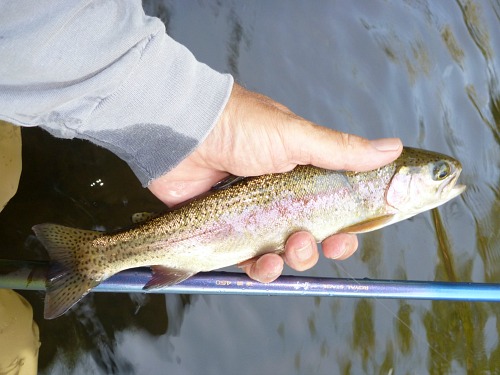 Caught using TenkaraBum Tactical Nymphing Sighter when fishing with a worm.
Caught using TenkaraBum Tactical Nymphing Sighter when fishing with a worm.I can report that the TenkaraBum Tactical Nymphing Sighter works quite well for Ultralight Worm Fishing also! In the past I have always used size 2.5 level line, which has just enough line sag to indicate strikes immediately. With about a foot of the white sighter between my 8X tippet and the 1X fluorocarbon tippet I was using as a casting line, strikes were just as apparent.
Late in the day, when the light was dim and there was a lot of glare on the water, the white became hard to see, but a section of orange over chartreuse stood out like a beacon.
Tactical Nymphing Sighter Specs
The new TenkaraBum Tactical Nymphing sighter has three 7'4" lengths of sighter material. Each length has 13" of white, followed by 18 1/2" of multicolor (black, orange, black, chartreuse, black), followed by 26" of white, then another 18 1/2" of multicolor (black, orange, black, chartreuse, black), and finally another 13" of white.
The white is extremely visible except against foam or glare (or a snowy streambank). The multicolored section is extremely visible against foam and the presence of the black bars makes it reasonably visible even against glare. It truly gives you more flexibility to customize your sighter for existing water and lighting conditions than any other sighter material on the market.
.011" (.285mm = Japanese line size 3 = 0X)
TenkaraBum Home > Tenkara Line > Tactical Nymphing Sighter
“The bitterness of poor quality remains long after the sweetness of low price is forgotten” - Benjamin Franklin
"Be sure in casting, that your fly fall first into the water, for if the line fall first, it scares or frightens the fish..." -
Col. Robert Venables 1662
As age slows my pace, I will become more like the heron.
Warning:
The hooks are sharp.
The coffee's hot.
The fish are slippery when wet.
Beware of the Dogma
Currently processing orders that were received Mar 8.
This Just In
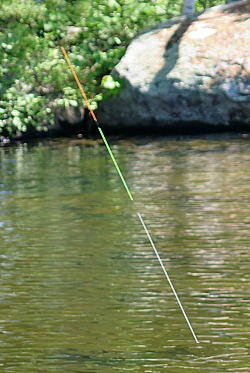 Effective in lakes also.
Effective in lakes also.Related Items
Want to give my (non-solicited) plug for this sighter. It's the best I've come across, and fits the tactical nymphing concept perfectly. Pairs well with the TBum 36 and 40 rods.
Rob W, Kentucky
Just wanted to send a quick note on the TenkraBum 40. I had an absolute blast fishing my local blue ribbon trout stream with it. I also took the tactical nymphing for a spin in some very high water conditions and it was mind blowing how well it worked.
Chris C, Utah
Visibility of the tactical nymphing indicator was very good in dappled light, full sun, and even looking straight into the glare of an evening sun.
All in all, I was very impressed.
Erik O, Utah
Wow man. I must say I really do love this line! At first I thought about just using the chartreuse part of the line. After using it I love the two tone contrast on the water in different shades of light. I was interested to see how the white part of the line did and I really think you are correct in the fact that the fish don't mind the white level line. I know for a fact and have seen fish part the waters like Moses in slower more clear water when my orange level line would go over their heads. I saw no flinches at the white so far! Thanks for telling me to double up the stop knot. Worked like a champ. Thanks a ton.
Jesse S, Colorado


